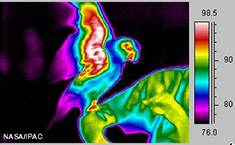Images
Images
Images are, perhaps, the most familiar way that astronomers look at light from cosmic objects.


Here are two very different images. On the left is an image of dalmatian; on the right is an image of a galaxy. (Credit: NASA's Imagine the Universe/Whitlock; NASA/STScI)
The two images above have one thing in common: they are optical light images. This is what the objects look like with our eyes (or, in the case of the galaxy, with our telescope-aided eyes). But an image can be made out of any kind of electromagnetic radiation. You just have to have the right kind of detector to 'see' the kind of radiation you want to study.
For example, let's say we want an infrared image of a parrot. We can do that with an infrared camera. Comparing the optical light to infrared, we would see something like this:


Image of a parrot in visible light (left) and infrared light (right). The area under the parrot's wings is very bright in infrared. Infrared shows us where things are warm or hot. The feathers under the parrot's wings are very thin, so more heat escapes the parrot from there. (Credit: NASA/IPAC via the Cool Cosmos site)
The infrared image above shows what we would see if our eyes were sensitive to infrared light instead of optical light. Heat from our bodies (and a parrot's body) is emitted as infrared light. The parrot is warm-blooded, so it radiates it's own heat, making it much warmer than it's surroundings. This can be seen in the image above, since the parrot shines much brighter in infrared light than its surroundings.
Astronomers do the same thing with light across the electromagnetic spectrum. They can use detectors of radio, infrared, optical, ultraviolet, X-ray and gamma-ray light to create images of stars and galaxies and other cosmic objects.
An image is just a way for scientists to plot or draw light. Most images show the brightness of an object in the spatial domain, i.e., how many photons are coming from a specific location in space. Three properties of an image – size, brightness, and resolution – are the most important properties of an image to a scientist. From size, we learn about astronomical scales, like how big the Moon is. From brightness, we learn the amount of energy that an object is producing, and then we may be able to figure out HOW it is producing that energy. The ability of a detector to tell one location from a nearby location is called spatial resolution. Higher resolution lets us know things like whether or not a planet has rings or if there are two stars close to each other, versus one star by itself.
![]() Tell me more about image size and resolution!
Tell me more about image size and resolution!
Looking at images of the same object made with different parts of the electromagnetic spectrum is a very important tool for scientists. Each different wavelength of light tells astronomers something unique about that object. By studying all different wavelengths and creating models that explain everything those images show, astronomers can see the "the big picture" of what is really going on with that object.

The Crab Nebula in different wavelengths: radio (top left) shows where free electrons are interacting with a magnetic field, optical (top right) shows where hydrogen is in the nebula, ultraviolet (lower left) shows cooler electrons, and X-ray (lower right) shows wehre very hot electrons are.
(Credit: Radio from NRAO; visible from Malin/Pasachoff/Caltech; ultraviolet from Hennessy et al, 1992, ApJL; X-ray from CXC.)
The figure above, shows four images of the Crab Nebula. The radio image tells about the magnetic fields and free electrons in the Nebula. The optical image tells about the hydrogen in the Nebula and more about the free electrons moving in the magnetic field of the pulsar. The UV image tells about the cooler electrons, while the X-ray image tells about the very hot electrons coming from the collapsed central object in the Nebula.
![]() Tell me more about multiwavelength astronomy!
Tell me more about multiwavelength astronomy!
![]() Use Hera to analyze
images.
Use Hera to analyze
images.
Updated: July 2013

